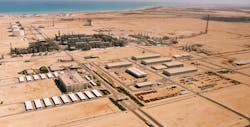Oil and gas exploration company ConocoPhillips has secured a $700,000 grant from Qatar Foundation's Qatar National Research Fund (QNRF) to develop an application using Forward Osmosis (FO) technology to treat produced wastewater from gas fields in Qatar.
Qatar has the third largest gas reserves in the world, estimated at 885 trillion cubic feet, which are estimated to last for another 160 years at 2011 production rates.
With petrochemical industries one of the largest users of water in the private sector, more companies are now actively looking to reuse produced wastewater, especially in areas where freshwater production is prohibitive.
ConocoPhillips’ Global Water Sustainability Center (GWSC) will lead the two-year forward osmosis project that aims to provide more information on desalination and volume reduction of petrochemical wastewaters.
Dr. Samer Adham, managing director of GWSC will serve as the lead principal investigator for the project and will be joined on the project by key members of the GWSC research team, including Raul Dores, Joel Minier Matar, and Arnie Janson, and by co-principal investigator (Co-PI), Professor Tony Fane, from Nanyang University of Singapore.
The $700,000 grant is part of the sixth cycle of the National Priorities Research Program, an initiative of the Qatar National Research Fund. The competition saw a total of 720 proposals submitted and only 137 selected, with a selection rate of a little less than 20%.
The FO process works whereby a draw solution is used to create a driving force for freshwater to pass through a membrane. An early commercial application for this idea was in the development of a sweetened drinking beverage for the US army (see WWi article on the principles of FO).
An impaired freshwater source such as a contaminated pond or brackish supply can provide the low salinity water source while a concentrated sugar solution provides the draw solution.
To date, while many companies have had commercial success with traditional reverse osmosis desalination, the same cannot be said for FO. UK company Modern Water has been the only company to have installations on a commercial scale in Oman (see WWi story).
Commenting on the Qatar funding, GWSC’s Adham said: "The project will generate data on an innovative desalination process (FO) that is important for treatment of produced water in Qatar. The same innovative technology was also recently proposed and pilot-tested on produced waters from unconventional resources in Texas and Pennsylvania."
###
Related Articles
Getting to know the Forward Osmosis Pioneer
Forward Osmosis: is China next to shake up the desalination sector?


